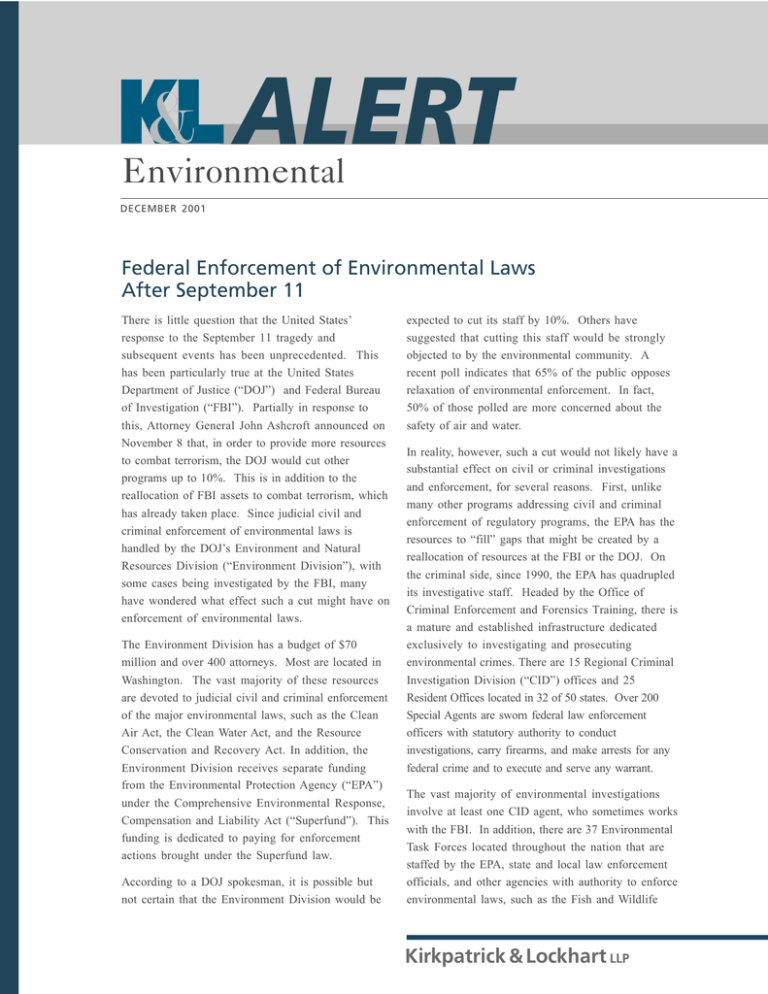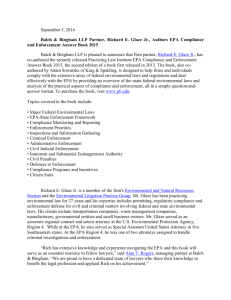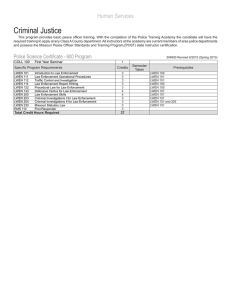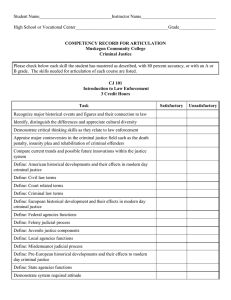
ALERT
Environmental
DECEMBER 2001
Federal Enforcement of Environmental Laws
After September 11
There is little question that the United States’
response to the September 11 tragedy and
subsequent events has been unprecedented. This
has been particularly true at the United States
Department of Justice (“DOJ”) and Federal Bureau
of Investigation (“FBI”). Partially in response to
this, Attorney General John Ashcroft announced on
November 8 that, in order to provide more resources
to combat terrorism, the DOJ would cut other
programs up to 10%. This is in addition to the
reallocation of FBI assets to combat terrorism, which
has already taken place. Since judicial civil and
criminal enforcement of environmental laws is
handled by the DOJ’s Environment and Natural
Resources Division (“Environment Division”), with
some cases being investigated by the FBI, many
have wondered what effect such a cut might have on
enforcement of environmental laws.
The Environment Division has a budget of $70
million and over 400 attorneys. Most are located in
Washington. The vast majority of these resources
are devoted to judicial civil and criminal enforcement
of the major environmental laws, such as the Clean
Air Act, the Clean Water Act, and the Resource
Conservation and Recovery Act. In addition, the
Environment Division receives separate funding
from the Environmental Protection Agency (“EPA”)
under the Comprehensive Environmental Response,
Compensation and Liability Act (“Superfund”). This
funding is dedicated to paying for enforcement
actions brought under the Superfund law.
According to a DOJ spokesman, it is possible but
not certain that the Environment Division would be
expected to cut its staff by 10%. Others have
suggested that cutting this staff would be strongly
objected to by the environmental community. A
recent poll indicates that 65% of the public opposes
relaxation of environmental enforcement. In fact,
50% of those polled are more concerned about the
safety of air and water.
In reality, however, such a cut would not likely have a
substantial effect on civil or criminal investigations
and enforcement, for several reasons. First, unlike
many other programs addressing civil and criminal
enforcement of regulatory programs, the EPA has the
resources to “fill” gaps that might be created by a
reallocation of resources at the FBI or the DOJ. On
the criminal side, since 1990, the EPA has quadrupled
its investigative staff. Headed by the Office of
Criminal Enforcement and Forensics Training, there is
a mature and established infrastructure dedicated
exclusively to investigating and prosecuting
environmental crimes. There are 15 Regional Criminal
Investigation Division (“CID”) offices and 25
Resident Offices located in 32 of 50 states. Over 200
Special Agents are sworn federal law enforcement
officers with statutory authority to conduct
investigations, carry firearms, and make arrests for any
federal crime and to execute and serve any warrant.
The vast majority of environmental investigations
involve at least one CID agent, who sometimes works
with the FBI. In addition, there are 37 Environmental
Task Forces located throughout the nation that are
staffed by the EPA, state and local law enforcement
officials, and other agencies with authority to enforce
environmental laws, such as the Fish and Wildlife
Kirkpatrick & Lockhart LLP
Service. So even if FBI resources otherwise
dedicated to investigating environmental crimes are
diverted, the infrastructure already created by the
EPA will continue to operate. However, Administrator
Whitman told the EPA Science Advisory Board on
November 28 that 40% of EPA criminal investigators
had been refocused to terrorism-related issues. What
that means remains unclear.
On the prosecution side, the EPA can also fill the
gap. While many cases are prosecuted either by an
Assistant United States Attorney or a member of the
Environmental Crimes Section at the DOJ, it is also
common for EPA counsel to assist in these cases.
Sometimes these counsel are designated as “Special
Assistant United States Attorneys” (“Special
Attorneys”) by the DOJ, giving them the authority to
appear in court and handle these cases. Every Regional
Office of the EPA has staff that focus on criminal
enforcement. There is nothing to preclude these
persons from assuming even greater responsibilities for
criminal enforcement through expanded Special
Attorney designations in the event DOJ and United
States Attorney staffs are otherwise occupied.
With respect to civil enforcement, the EPA has even
greater flexibility to assume a larger enforcement role
in the event the DOJ is otherwise occupied. As with
criminal enforcement, each EPA Region has a civil
enforcement staff that can be authorized by the
Attorney General to handle enforcement cases
brought in federal court. Even more significantly,
however, the agency could decide to handle more
cases using its administrative enforcement powers,
rather than seeking relief in federal court. This would
be particularly appropriate for cases seeking
penalties as opposed to injunctive relief. Examples
include cases arising under the Clean Air Act, the
Clean Water Act, the Toxic Substances Control Act,
the Resource Conservation and Recovery Act, the
Federal Insecticide, Fungicide and Rodenticide Act,
and the Employee Protection and Community Right
to Know Act.
Finally, a cut may not be likely in light of pending
legislation that would increase the authority of both the
EPA and DOJ to use the judicial system to address
potential chemical threats. Senate bill 1602 would allow
the EPA to issue administrative orders and secure relief
through litigation brought by the DOJ where there is an
“imminent and substantial endangerment from a
potential accident or criminal release.” It would also
require the EPA to work with the DOJ and others to
identify “high priority” chemical production,
processing, transportation, and disposal facilities.
All of these factors strongly suggest that federal civil
and criminal environmental enforcement will continue at
current levels. The regulated community must remain
particularly vigilant because enforcement personnel
from the EPA may well have different views of whether
particular conduct should be viewed as criminal.
BARRY M. HARTMAN
bhartman@kl.com
202.778.9338
FOR FURTHER INFORMATION about criminal enforcement
of environmental laws or Kirkpatrick & Lockhart’s environmental
practice, please consult the author or one of the Kirkpatrick &
Lockhart LLP office contacts listed below. You may also visit
our webpage at www.kl.com.
Roger C. Zehntner
Stephen A. Kennedy
R. Timothy Weston
Paul W. Sweeney, Jr.
Daniel A. Casey
Anthony P. La Rocco
Warren H. Colodner
Richard W. Hosking
Mark A. Rush
Edward P. Sangster
Barry M. Hartman
Boston
Dallas
Harrisburg
Los Angeles
Miami
Newark
New York
Pittsburgh
Pittsburgh
San Francisco
Washington
617.261.3149
214.939.4917
717.231.4504
310.552.5055
305.539.3324
973.848.4014
212.536.3912
412.355.8612
412.355.8333
415.249.1028
202.778.9338
rzehntner@kl.com
skennedy@kl.com
tweston@kl.com
psweeney@kl.com
dcasey@kl.com
alarocco@kl.com
wcolodner@kl.com
rhosking@kl.com
mrush@kl.com
esangster@kl.com
bhartman@kl.com
SM
Kirkpatrick & Lockhart LLP
Challenge us.
SM
BOSTON
●
DALLAS
●
HARRISBURG
●
LOS ANGELES
●
MIAMI
●
NEWARK
●
NEW YORK
●
PITTSBURGH
●
SAN FRANCISCO
●
WASHINGTON
.........................................................................................................................................................
This publication/newsletter is for informational purposes and does not contain or convey legal advice. The information herein
should not be used or relied upon in regard to any particular facts or circumstances without first consulting with a lawyer.
© 2001 KIRKPATRICK & LOCKHART LLP. ALL RIGHTS RESERVED.





